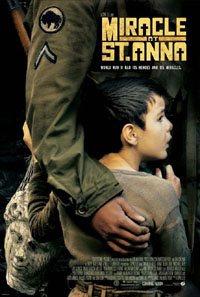 MIRACLE AT ST. ANNA
MIRACLE AT ST. ANNA(R)
** (out of 5)
September 26, 2008
STARRING
Derek Luke as AUBREY STAMPS
Michael Ealy as BISHOP CUMMINGS
Laz Alonso as HECTOR NEGRON
Omar Benson Miller as SAM TRAIN
Pierfrancesco Favino as PEPPI GROTTA
Valentina Cervi as RENATA
Studio: Touchstone
Directed by: Spike Lee
BY KEVIN CARR
I feel sorry for Spike Lee. He is, after all, a tremendously talented filmmaker. However, with his new film “Miracle at St. Anna,” his personal issues, political views and overbearing ego gets in the way of making a good movie.
This film first gained national attention last year when Lee complained about Clint Eastwood’s film “Flags of Our Fathers” and how few African Americans were shown. To show Eastwood how to do a real war film, Lee pumped up his latest film.
“Miracle at St. Anna” begins in New York in the 1980s. A mild-mannered Post Office employee suddenly guns down a customer in cold blood. The police investigation that follows turns up a priceless Italian artifact buried in the perpetrator’s closet. A young reporter visits the man in jail in order to get his story.
The film then takes us back to 1944 in Tuscany, Italy. Several platoons of African American soldiers are advancing on the German front line. A bloody firefight kills most of them but leaves four survivors who miraculously fall behind the enemy line. While trying to escape, the soldiers pick up a lone Italian child and hide in a local village, which happens to be a hotbed of partisan activity and a target of the Nazis.
I know that Lee’s intention was to show the contributions of African American soldiers during World War II. However, he does these men a disservice by perpetuating the very stereotypes that he rails against. Rather than being good soldiers who know how to fight, these four GIs are insubordinate, disorganized, cowardly and incompetent. He even goes as far to showcase a horny black soldier with a sparkling gold tooth who is more interested in bedding the pretty Italian girl than carrying out orders from his superiors.
I am in utter amazement that Lee didn’t realize how racist his portrayal of his own heroes are. I would imagine that if Clint Eastwood dropped these characters into his film, with them talking 70s jive, chasing skirt and flat out refusing to respect the chain of command, Lee would have tarred and feathered him.
But let’s set aside the stereotyping and racial preaching for a second. As a movie, the film is way too long, clocking in at 166 minutes. The plot is convoluted, not able to focus on any real main character. It’s not the soldiers’ movie. It’s not the villagers’ movie. It’s not the partisans’ movie. Heck, the story doesn’t even belong to the mysterious young Italian boy.
Moreover, the film’s dramatic tension wraps itself around the infamous Sant’Anna di Stazzema massacre. However, word is that the survivors of this massacre and many of the people from this area of Italy are upset at Lee’s bending of history to tell his tale. So, in order to give what he considers just due to the underrepresented minority soldiers, Lee manages to alienate the survivors and victims’ families of a war atrocity.
Over the years, I have applauded Spike Lee for working outside of his racially self-imposed box. While films like “The 25th Hour” and “Inside Man” weren’t awesome, they were interesting and showed that he has grown as a director. However, with “Miracle at St. Anna” he’s up to his old tricks again, blaming race for everything and implying that most – if not all – white people are racist in some way.
And this is a shame because Spike Lee is such a visionary filmmaker that he could rise above this and make much, much better films.
